| Reviews & Columns |
|
Reviews DVD TV on DVD Blu-ray 4K UHD International DVDs In Theaters Reviews by Studio Video Games Features Collector Series DVDs Easter Egg Database Interviews DVD Talk Radio Feature Articles Columns Anime Talk DVD Savant Horror DVDs The M.O.D. Squad Art House HD Talk Silent DVD
|
DVD Talk Forum |
|
|
| Resources |
|
DVD Price Search Customer Service #'s RCE Info Links |
|
Columns
|
|
|
Boy In The Plastic Bubble (Sony Choice Collection), The
Uh...they couldn't just adopt? Sony's Choice Collection vault of hard-to-find cult and library titles has released The Boy in the Plastic Bubble, the legendary 1976 made-for-TV movie starring John Travolta, Glynnis O'Connor, Robert Reed, Diana Hyland, and Ralph Bellamy. One of the most fondly-remembered "disease of the week" MTV movies from that genre's "golden age," The Boy in the Plastic Bubble, released right before Travolta fever really exploded, was a huge ratings' hit for ABC when it premiered, becoming one of those shared TV events (back in the days of only three network channels) that millions of people my age can point to as an easily recognizable pop culture touchstone. Now...it may play fast and loose with the facts, and its science is questionable at best, but as a sweet teen love story, it's hard to beat. Fans of The Boy in the Plastic Bubble who had had to put up with all those blurry, washed-out, noisy public domain copies of the title will want to grab this Sony Choice Collection version now: its sharp, colorful transfer is terrific.
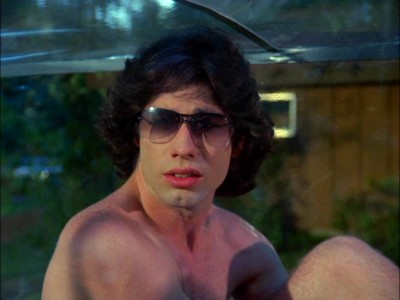
1959. Johnny and Mickey Lubitch (Robert Reed and Diana Hyland), apprehensive about Mickey's latest pregnancy after losing their first baby to an insufficient immune system, decide to go ahead with their next pregnancy after learning from their doctor that the odds are only 25% that this baby will suffer the same affliction. Almost immediately after birth, Dr. Gunther (Ralph Bellamy) tells the anxious parents that Tod won't be able to live a normal life, since even the most innocuous germ could cause his death. Little Tod (Seth Wagerman) spends his first years at the hospital in a germ-free environment, never touched by human hands, before Mickey's desire to have Tod at home spurs the hospital to help the Lubitches to create a similar environment for Tod at their home. Little next-door-neighbor Gina Biggs (Kimberly Kirsch) is brought around for Tod's solitary birthday parties, but as she and Tod grow older, high schooler Gina (Glynnis O'Connor), fascinated and repulsed by the reclusive Tod (John Travolta), views him a pathetic, strange creature. Advances in technology like closed-circuit TV and later a space suit, help Tod branch out, actually leaving his environment to attend school, but his stunted emotional development, along with the realization that he's probably never going to leave his plastic "bubble," cause him untold anguish as he finds himself falling in love with Gina.
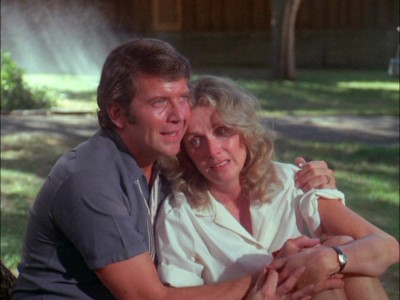
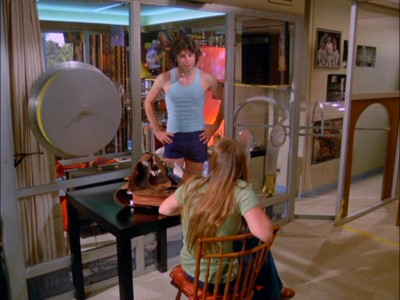
Of course with seemingly unending repeats of Seinfeld out there, the term "bubble boy" has taken on a whole new context, but for viewers my age, chances are the first image that comes to mind when you hear that phrase is a young John Travolta mooning at Glynnis O'Connor behind walls of Visquine®. From what I've read, The Boy in the Plastic Bubble was loosely based on two real-life medical cases. Combined biographical elements of the lives of David Vetter, who was born with Severe Combined Immunodeficiency (SCID), and Ted DeVita, who developed severe aplastic anemia when he was ten years old, were used as inspiration for The Boy in the Plastic Bubble's screenplay, written by Douglas Day Stewart (The Other Side of the Mountain Part II, The Blue Lagoon, An Officer and a Gentleman, Thief of Hearts), from a story by film critic Joe Morgenstern. After reading about the frankly terrifying, heartbreaking lives these young boys led (David only lived 12 years, and Ted 18), it's readily apparent how Charlie's Angles and The Love Boat producers Aaron Spelling and Leonard Goldberg sanitized and thus made far more palatable, this horrifying medical condition.
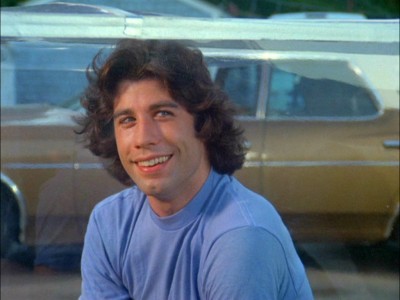
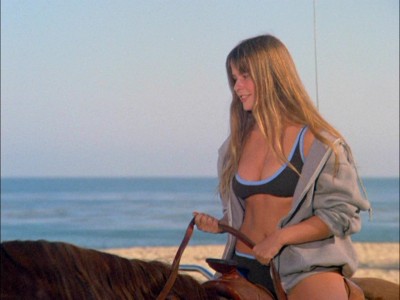
Of course, it isn't necessary for The Boy in the Plastic Bubble to be a documentary to be entertaining or "worthwhile," and certainly within the context of network TV standards in 1976, nobody was going to show what really happened to David Vetter and Ted De Vita, anyway, both of whom became mentally unstable due to their complete lack of human touch and their isolation within their hermetically sealed worlds. Instead, The Boy in the Plastic Bubble plays it "afterschool special" safe by largely avoiding any serious look at the rather uncomfortable realities of these two boys' situations. Whether or not Reed and Hyland should have gone ahead with the birth is ameliorated by the real odds of it happening getting reduced here in the screenplay (in Vetter's case, it was 50%), while Reed and Hyland come off as innocents to the sympathetic audience, when Bellamy, at the birth, informs the startled parents that Tod will now have to live in a bubble indefinitely (as if they wouldn't have already been aware of that). Other real details, small and large, are fudged (neither boy liked or often used the "space suit" that Travolta so easily cavorts around in, without disinfecting it), while the screenplay's biggest dodge here―we're constantly told Tod's antibodies are building up―gives the viewer plenty of room to breathe whenever the terrible reality of Tod's situation actually settles in, as somewhere in the back of the viewer's mind, he or she confidently holds out for a happy ending.
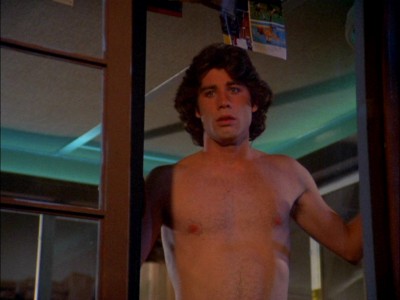
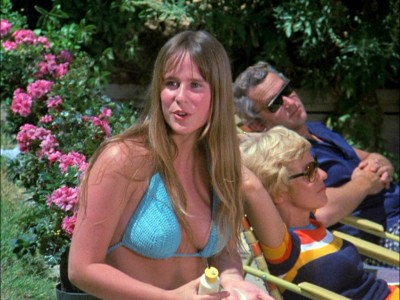
As a metaphor for awkward, heartbreaking teen loneliness, finding first love, and growing up, however, The Boy in the Plastic Bubble more than succeeds, giving us a love story that's sensitively, even beautifully at times, rendered. All teen romances and first love stories need an obstacle to keep the young people apart, whether it's class or family distinctions (Romeo and Juliet), or race (Romeo and Juliet-lite West Side Story), or disapproving parents (Love Story), but The Boy in the Plastic Bubble's absolute physical barrier―that plastic sheathing that literally separates Tod from all human kind―is a potent, compelling dramatic device. Living in the bubble his whole life has retarded his emotional growth, and in an odd, strange way that she at first completely rejects, it has fascinated Gina her whole life, and eventually draws her to Tod. Out off all the possible "impossible" obstacles for two lovers that have been put forth in romantic drama, the complete physical separation of Tod and Gina is one of the best, creating can't-miss suspense and a poignant tension of possibility and futility.
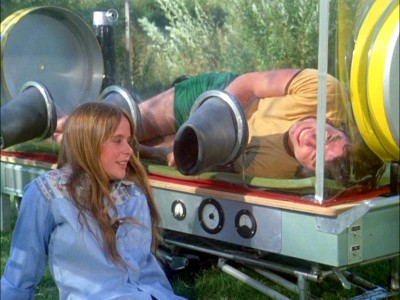
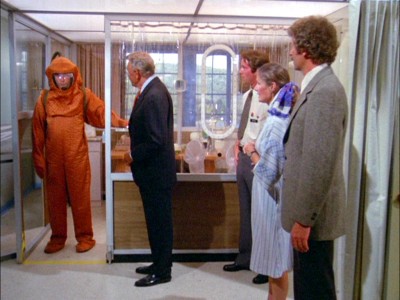
No matter how clever (or manipulative, if you rather) the set-up, the real key to the success of The Boy in the Plastic Bubble lies in the performances, with credit also going to director Randall Kleiser (TV's The Gathering, Grease, The Blue Lagoon) for keeping any histrionics out. Kindly, reassuring Ralph Bellamy doesn't have much to do here, but Reed and Hyland make solid impressions during the movie's first half, before Travolta and O'Connor take over. Reed, only recently departed from his hated The Brady Bunch, shows what a subtle, shaded dramatic actor he could be, given the right material, while Hyland also never rings false in her highly emotional, well-tuned turn (as good as they are here, it's a shame they couldn't go to other levels, considering the movie's largely hands-off approach to their characters' culpability in Tod's situation, and no scenes showing any real conflict between them, due to Tod's illness). O'Connor, already a known quantity with the young, moony girls who caught her in Jeremy and Ode to Billy Joe with Robby Benson, does an excellent job of getting across Gina's selfishness and cruel teasing of Tod, before she believably comes to realize―and not all that welcome of a realization―that she does have feelings for a boy in an impossible situation. It's a refreshingly natural performance that well captures a typical teenager's slightly self-centered, slightly unkind initial responses to such a situation, before turning warm and understanding and accepting of Tod (...and looking good in a bikini didn't hurt her with male viewers, either). As for Travolta, his painfully shy, awkward, intelligent Tod is about as far away from his broadly comedic turn as Vinnie Barbarino on his then-smash sitcom, Welcome Back, Kotter, as you can get. It's a notably sympathetic, technically accomplished effort for such a difficult character, from an actor whose hugely successful, iconic movies Saturday Night Fever, Grease, and to a lesser extent, Urban Cowboy, would soon define him as a "type" (teen heartthrob) and a "superstar," while overshadowing what a proficient actor he could be (his superlative turn in the utterly ignored Blow Out is an excellent example). Just watch the control―and star-worthy audience connection―he has at the end of The Boy in the Plastic Bubble, when his character SPOILER ALERT! decides that staying in the bubble, no matter what the cost, isn't worth it anymore. A beatific smile spreading across his face, Travolta touches the leaves and trees, and O'Connor's face, before they, to the mellow teen rebellion sounds of diminutive Paul Williams warbling Leave Us Alone, literally ride off into the sunrise on a horse. It sounds schmaltzy and corny as described, but as played by O'Connor and Travolta, it's a genuinely moving climax to a equally surprising, effective coming-of-age romance.
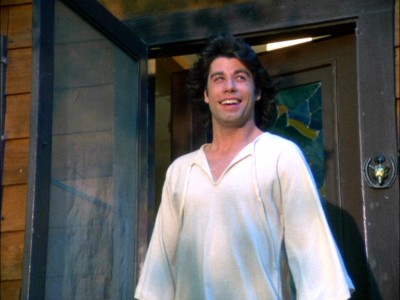

The DVD:
The Video:
The full-frame, 1.37:1 transfer for The Boy in the Plastic Bubble is near-perfect...compared with all those awful public domain copies of the movie out there. Saturated color, a sharp image, and few imperfections make this a real winner.
The Audio:
The Dolby Digital English mono audio track is just fine: decent re-recording level, and low hiss. No subtitles or closed-captions, though.
The Extras:
No extras or even a menu: the movie just starts and keeps looping when it's finished.
Final Thoughts:
As science or biography, The Boy in the Plastic Bubble plays it too coy and cozy...good thing no one intended it as "science" or "biography." As sensitive, tortured, impossible (and impossibly hopeful) teen romance, though, The Boy in the Plastic Bubble scores big time. I'm highly, highly recommending The Boy in the Plastic Bubble.
Paul Mavis is an internationally published movie and television historian, a member of the Online Film Critics Society, and the author of The Espionage Filmography.


|
| Popular Reviews |
| Sponsored Links |
|
|
| Sponsored Links |
|
|
| Release List | Reviews | Shop | Newsletter | Forum | DVD Giveaways | Blu-Ray | Advertise |
|
Copyright 2024 DVDTalk.com All Rights Reserved. Legal Info, Privacy Policy, Terms of Use,
Manage Preferences,
Your Privacy Choices | |||||||














